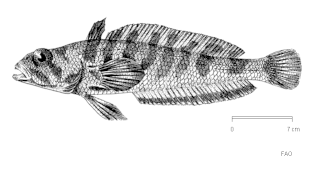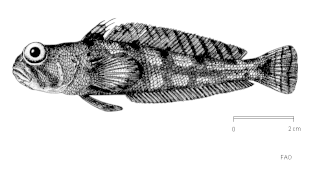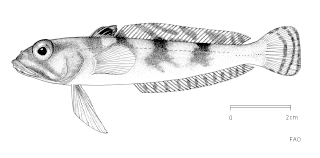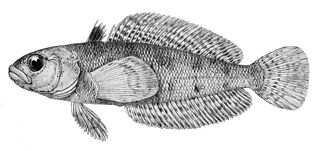
Nototheniidae, the notothens or cod icefishes, is a family of ray-finned fishes, part of the suborder Notothenioidei which is traditionally placed within the order Perciformes. They are largely found in the Southern Ocean.

The marbled rockcod is a species of marine ray-finned fish, belonging to the family Nototheniidae, the notothens or cod icefishes. It is native to the Southern Ocean, where it can be found at depths from 5 to 350 m. This is a commercially important species.

Notothenia is a genus of marine ray-finned fishes belonging to the family Nototheniidae, the notothens or cod icefishes with the species in this genus often having the common name of rockcod. They are native to the Southern Ocean and other waters around Antarctica.

The painted notie, or painted notothen, is a species of marine ray-finned fish, belonging to the family Nototheniidae, the notothens or cod icefishes. It is native to the Southern Ocean.

Dolloidraco is a monotypic genus of marine ray-finned fish, its only known species being Dolloidraco longedorsalis, belonging to the family Artedidraconidae, the barbeled plunderfishes. It is native to the Southern Ocean in the waters around Antarctica.

Mawson's dragonfish is a species of Antarctic dragonfish native to the Southern Ocean around Antarctica. It is found at depths of from 110 to 300 metres over the continental shelf. This species is the only known member of its genus.
Gerlachea is a monotypic genus of marine ray-finned fish belonging to the family Bathydraconidae, the Antarctic dragonfishes, its only species is Gerlachea australis. It is found at depths of from 200 to 670 metres over the Antarctic continental shelf. This species is the only known member of its genus.

The ploughfish is a species of Antarctic dragonfish native to the Southern Ocean around Antarctica. It is found at depths of from 0 to 550 m over the Antarctic continental shelf. This species is the only known member of its genus.

The emerald rockcod, also known as the emerald notothen is a species of marine ray-finned fish belonging to the family Nototheniidae, the notothens or cod icefishes. It is native to the Southern Oceanwhere it is acommercially important species.

Gobionotothen is a genus of marine ray-finned fishes belonging to the family Nototheniidae, the notothens or cod icefishes. They are native to the Southern Ocean.

The grey rockcod, also known as the grey notothen, stripe-eyes notothen or stripe-eyed rockcod, is a species of marine ray-finned fish belonging to the family Nototheniidae, the notothens or cod icefishes. It is native to the Southern Ocean,The grey rockcod feed mainly on macrozooplankton and is of minor importance to commercial fisheries. It is the only species in the genus Lepidonotothen

The toad notie, or toad notothen, is a species of marine ray-finned fish, belonging to the family Nototheniidae, the notothens or cod icefishes. It is native to the Indian sector of the Southern Ocean.
Nototheniops is a genus of marine ray-finned fishes belonging to the family Nototheniidae, the notothens or cod icefishes. The species in this genus are native to the Southern Ocean.

Lindbergichthys nudifrons, the yellowfin rockcod, also known as the yellow notie or the gaudy notothen, is a species of marine ray-finned fish, belonging to the family Nototheniidae, the notothens or cod icefishes. It is native to the Atlantic sector of the Southern Ocean.

Patagonotothen guntheri, the yellowfin notothen, is a species of notothen found in the Argentinian region of Patagonia, the Falkland Islands, the Burdwood Bank and the Shag Rocks west of South Georgia on the continental shelf at depths of 120-250 m, but may be found in waters deeper than 250 m in the Argentinian region.

Gobionotothen gibberifrons, the humped rockcod or the humphead notothen, is a species of marine ray-finned fish belonging to the family Nototheniidae, the notothens or cod icefishes. It is native to the islands of the Scotia Arc, the northern part of the Antarctic Peninsula, and Heard Island in the Southern Ocean. This species inhabits depths of 6-429 m, but is most abundant at depths of 100-400 m, at least around Elephant Island.
Gobionotothen acuta, the triangular rockcod or the triangular notothen, is a species of marine ray-finned fish belonging to the family Nototheniidae, the notothens or cod icefishes. It is native to the French Southern and Antarctic Lands, the Heard Islands and the Kerguelen Plateau in the Southern Ocean.

Notothenia cyanobrancha, the blue rockcod, bluegillnotothen, or bluegill rockcod, is a species of marine ray-finned fish, belonging to the family Nototheniidae, the notothens or cod icefishes. It is native to the Kerguelen and Heard Islands in the Southern Ocean.
Patagonotothen brevicauda, the Patagonian rockcod, is a species of marine ray-finned fish, belonging to the family Nototheniidae, the notothens or cod icefishes. It is native to oceans of the Patagonian region, including Tierra del Fuego, the Strait of Magellan, the Beagle Channel and the Falkland Islands.

The stocky rockcod, also known as the bandtail notothen, is a species of marine ray-finned fish belonging to the family Nototheniidae, the notothens or cod icefishes. It is found in the Southern Ocean.















